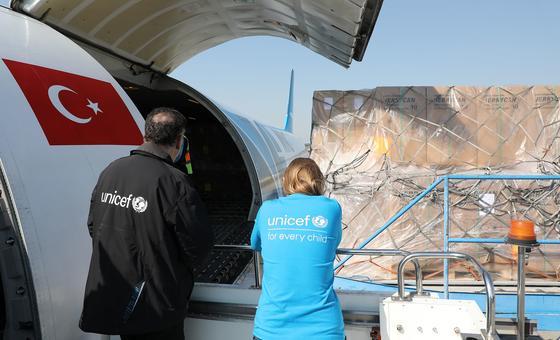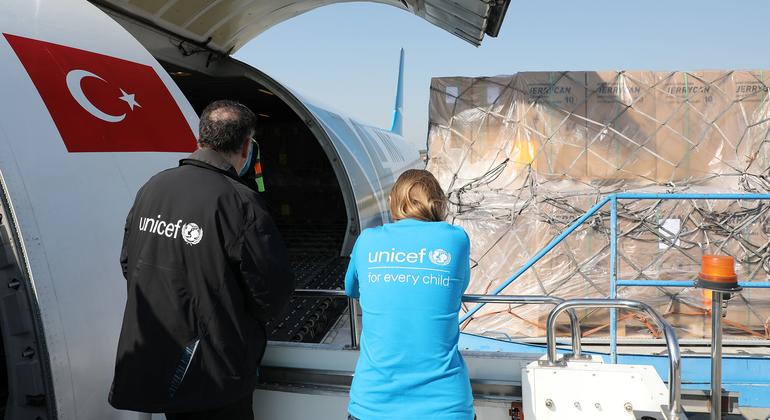
“This makes this clearly the largest earthquake disaster in Türkiye’s history and perhaps the largest natural disaster the country has ever faced,” said Louisa Vinton, UN Development Programme (UNDP) Türkiye Resident Representative.
Two further earthquakes measuring 6.4 and 5.8 on the Richter Scale killed six more on the Türkiye-Syria border on Monday, with “another 294 people injured and another few buildings collapsed in the region around Hatay and some on the Mediterranean coast”, the UNDP official continued.
Syria aid lifeline continues
In northwest Syria, where up to nine million people have been affected, and at least 6,000 killed, the international humanitarian response has continued. A total of 227 trucks loaded with supplies have crossed from Türkiye since 9 February; 195 using the Bab al-Hawa crossing, 22 across Bab al-Salam and 10 across Al Ra’ee.
Speaking to journalists via video link from Gaziantep in southern Türkiye, Dr. Catherine Smallwood, Earthquake Incident manager for the UN World Health Organization (WHO) in Europe, noted that the agency had transported “close to 100 tonnes across the border from Türkiye” since the disaster, in addition to the supplies that were already pre-positioned within Syria.
Mobile medical solutions
These supplies included essential medicines, consumables, anaesthesia drugs, surgical equipment and other medical supplies for an additional 40,000 to 49,000 interventions for those in need of surgical support or medical support for earthquake-specific injuries.
The WHO official added that 55 medical facilities have been damaged and several “completely destroyed”, but that six mobile clinics had been redeployed to the towns and communities surrounding Jindires, one of the most affected areas in northwest Syria.
“These are roaming clinics that provide support, support and medical services directly to the populations,” Dr. Smallwood explained.
Residents who survived the earthquake are left in extremely cold temperatures without drinking water, electricity, or fuel for heating, and are exposed to the danger of crumbling buildings as they try to seek shelter, warned the UN Economic and Social Commission for Western Asia (ESCWA).
Cross-line aid progress
Potentially positive news also emerged concerning cross-line aid deliveries from Damascus into Idlib, which is largely controlled by opposition armed forces and where 4.1 million people are almost entirely dependent on humanitarian aid, after well over a decade of war in Syria.
“On Sunday 19 February and Monday 20, three Syrian Arab Red Crescent convoys of humanitarian assistance crossed to Sheikh Maqsood, a non-government controlled area north of Aleppo. And so, we are speaking about cross lines here,” confirmed Tommaso Della Longa, spokesperson for the International Federation of Red Cross and Red Crescent Societies (IFRC).
Wasteland
Highlighting the staggering scale of the reconstruction challenge ahead, UNDP’s Louisa Vinton explained an estimated 116 to 210 million tonnes of rubble would have to be cleared away first.
“To give you a frame of reference, the last major earthquake in Turkey, in 1999, which also had a high number of casualties, although less than less than half of what we’re seeing now, that resulted in 13 million tonnes of rubble,” she said.
In past disasters after earthquakes and explosions in Nepal, Haiti, Lebanon, and also Ukraine, UNDP has partnered projects to ensure that rubble is dealt with in an environmentally safe way. “Much of it can be recycled for construction and it can also be used as a way of generating income short term,” Ms. Vinton explained.



